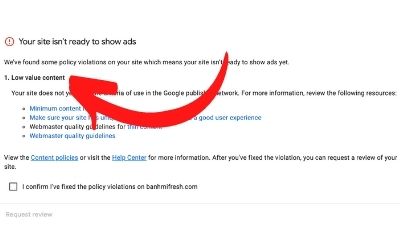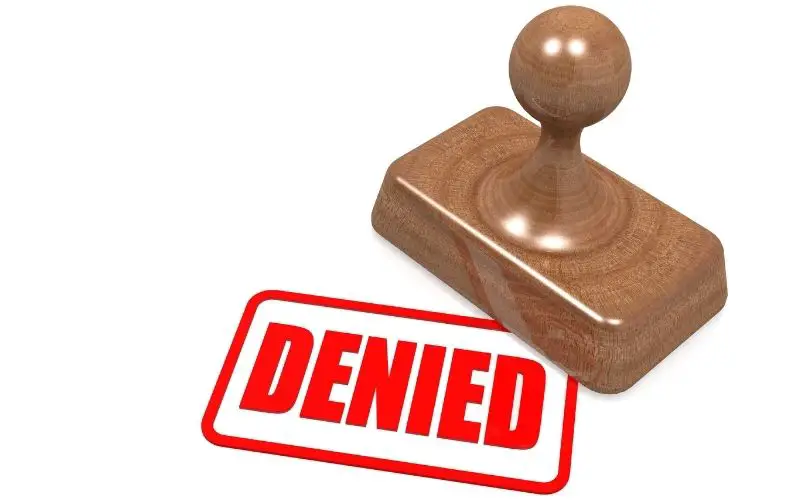Table of Contents
It can be extremely frustrating when applying for Google Adsense. What’s worst is that you’ve been waiting for weeks, and finally, you get an email telling you that your request has been denied because of “Low content value.”
Before we move on, I wanted to say that I was rejected almost 5 times over the span of 4 months from Google Adsense. Two out of five of those reasons were because of “Low Content Value.” But with a lot of hard work, I got past it and I want to share what I’ve learned.
While Google’s Adsense team doesn’t provide specific details to every situation, there are a few things you can do to fix this issue.
What does “Low Content Value” mean?

Believe it or not, one of Google Adsense’s criteria for being approved is that your site needs to have reached a certain amount of content and this content has to be unique and valuable.
It’s important to understand that Low Content Value can mean a number of things. Perhaps Google is trying to be as general as possible since giving a long explanation to each situation would take up a lot of resources.
When you get an email denying you due to low content value, it’s most likely because your site doesn’t have enough articles or content on it. At least in the eyes of the site reviewer assigned to your application, you’re going to have to continue to add more content. Now, you can do this in many ways.
Let’s talk about all the possible cases that you need to consider.
What you need to know
Looking forward, you’re going to have to prepare to continue with what you’re doing. But I’ve listed a few of the points that Google wants you to consider below when you build your site.
Minimum content requirements
On Google’s official website, Google states that they, “do not allow monetization where there is no content. No content includes placeholder content for sites or apps under construction.”
Believe it or not, in the early days, people would apply for Google Adsense right after starting their site. There would be no content, no helpful information, and no known purpose to their site.
Since then, Google had to create criteria and bar a minimum threshold on how much content a site actually needs before they get Adsense approval.
Unique high-quality content and good user experience
Google wants high-quality unique content. So you’re going to have to make sure that you also have enough unique content for AdSense to approve you.
Under the official website, they state that this kind of content needs to be interesting or helpful enough that your visitors are attracted to your site and will even return for more information.
To be honest with you, every year is that Google can only verify the uniqueness of your content by mainly checking to see if it’s plagiarized or not.
In most cases, this will probably not be an issue with your site as long as you didn’t just blatantly copy your content from another source.
However, a few of the kinds of content that Google will not approve are those that are automatically generated content, affiliate programs, scraped content, and doorway pages.
Thin content guidelines
Again, the 4 most common types of violations to unique content are also considered thin in Google’s eyes. And, I could see this being true since automatically generated content, thin affiliate pages, content sourced or scraped from other sites doesn’t really provide the kind of value that is up to Google’s expectations.
Starting with gateways, you don’t want to create a list of keywords that are all links that lead to another page. Google won’t approve of these and are able to filter through to identifying these.
For people who are using affiliate links, try to make sure you are giving helpful information about this product or service you’re promoting. Rather than just copying down the description of the product, add reviews, advantages, disadvantages, and etc.
Also, plagiarism is a big violation. Just don’t do it.
Webmaster quality guidelines
Adding to Thin content guidelines, this section simply reiterates the point of making sure you don’t duplicate content, create unique value for readers, avoid spammy affiliate links with no real review, and avoid doorway pages.
Avoid Google Forums
While this is a forum created by Google. No one at Google actually listens to or reads the forums. It’s more of a free-for-all forum where the more you participate the more you rank up. This creates a false label on many of the member’s handles claiming that they are the “experts” when they are as much in the dark about things as anyone else.
Let me give you an example. I spent the last 3 to 4 months trying to get Adsense approval and I asked a lot of questions in the forum. The one answer they kept giving me was that my type of site has been written about over and over now and that Google no longer accepted sites in this particular niche.
That turned out to be absolutely untrue. In fact, it makes no sense. Google isn’t trying to limit its sources for ad revenue. As a business, they should always be promoting more and more websites since websites make them money.
What should you do to fix “Low Content Value”?
Continue posting unique content
This is the very answer to fixing this issue. I really can’t stress it enough. Put your head down for the next month and crank out as much original work as you can. This is what I did and how I got through to the Adsense team.
Some people have claimed that your site must be at least a few months old and have more than 30 to 40 articles with about 800 to 1200 words in each.
If you’re new to blogging and you’re not used to writing, don’t give up. I know. I’ve been there. I’m still there in fact. But I sucked it up and I continued to write. I continued to focus on this goal.
By the time I was approved, I had about 30 strong articles backed by a 3.5-month-old site.
Make sure your articles are indexed
Go to Google Search Console, and make sure your site is indexed. Getting indexed means getting Google to actually recognize your site and rank it.
Let’s say your site has almost 40 articles or more. However, if only half of those articles are indexed into Google Search servers, then Google can only see 20 articles.
I’m not sure if this plays a major factor in getting approval.
However, this was one of the things I did after getting the Low Content Value message.
Get more page viewers
This may seem difficult, but your goal should be to attract as many viewers as possible before and after getting approved for Google Adsense.
I would guess to say that while your site is being reviewed, its page view count may also play a factor in your approval.
Google doesn’t want to approve a site that has never gotten a single pageview. It would make them no money.
You can either create more content in hopes that you get organic traffic. You can become more active and promote yourself on social media bringing traffic back to your site. You can also create YouTube videos that have a call to action for viewers to get more helpful information back to your site.
Avoid empty categories on your top navigation menu
This is a little trick I’ve learned. At first, I wanted to set up my full site; making sure all my categories were laid out on my homepage. However, this came to me as a rejection indicated by Google as “Navigation.”
What I did to fix this issue was create only categories that I already have plenty of content in.
My theory to this is that it will give the reviewer the perspective that my site simply has only 3 categories and all 3 categories have plenty of content in it.
During my rejection, I had about 7 to 8 categories with more than half of them empty. Google doesn’t like that. Just remove the empty categories and add them later on when you create content for them.
The bottom line
After over 3 months, close to 35 articles, and 2 “Low Content Value” rejections, I was finally able to successfully get approved for Adsense.
In fact, I tried the same method again and got approved for a second site with way fewer rejections.
Obviously, “Low Content Value” isn’t the only rejection you can get with Google Adsense, but at least in this article, I hope it helps you get past this point.
Other interesting articles:
